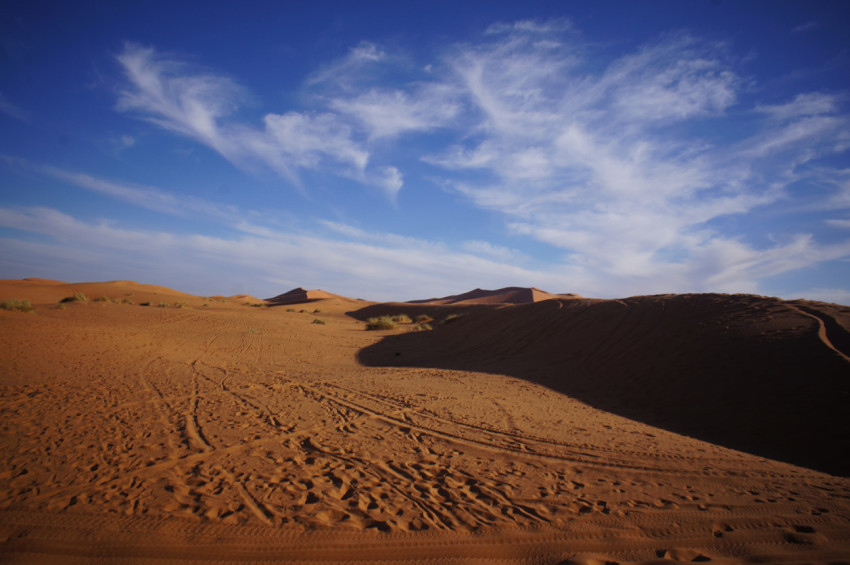Algeria’s Tassili N’Ajjer plateau is Africa’s largest national park. Among its vast sandstone formations is perhaps the world’s largest art museum. Over 15,000 etchings and paintings are exhibited there, some as much as 11,000 years old according to scientific dating techniques, representing a unique ethnological and climatological record of the region.
Curiously, however, these images do not depict the arid, barren landscape that is present in the Tassili N'Ajjer today. Instead, they portray a vibrant savannah inhabited by elephants, giraffes, rhinos and hippos. This rock art is an important record of the past environmental conditions that prevailed in the Sahara, the world’s largest hot desert.
These images depict a period approximately 6,000-11,000 years ago called the Green Sahara or North African Humid Period. There is widespread climatological evidence that during this period the Sahara supported wooded savannah ecosystems and numerous rivers and lakes in what are now Libya, Niger, Chad and Mali.
This greening of the Sahara didn’t happen once. Using marine and lake sediments, scientists have identified over 230 of these greenings occurring about every 21,000 years over the past eight million years. These greening events provided vegetated corridors which influenced species’ distribution and evolution, including the out-of-Africa migrations of ancient humans.
These dramatic greenings would have required a large-scale reorganization of the atmospheric system to bring rains to this hyper arid region. But most climate models haven’t been able to simulate how dramatic these events were.
As a team of climate modellers and anthropologists, we have overcome this obstacle. We developed a climate model that more accurately simulates atmospheric circulation over the Sahara and the impacts of vegetation on rainfall.
We identified why north Africa greened approximately every 21,000 years over the past eight million years. It was caused by changes in the Earth’s orbital precession - the slight wobbling of the planet while rotating. This moves the northern hemisphere closer to the sun during the summer months.
This caused warmer summers in the northern hemisphere, and warmer air is able to hold more moisture. This intensified the strength of the West African Monsoon system and shifted the African rainbelt northwards. This increased Saharan rainfall, resulting in the spread of savannah and wooded grassland across the desert from the tropics to the Mediterranean, providing a vast habitat for plants and animals.
Our results demonstrate the sensitivity of the Sahara Desert to changes in past climate. They explain how this sensitivity affects rainfall across north Africa. This is important for understanding the implications of present-day climate change (driven by human activities). Warmer temperatures in the future may also enhance monsoon strength, with both local and global impacts.
Earth’s changing orbit
The fact that the wetter periods in north Africa have recurred every 21,000 years or so is a big clue about what causes them: variations in Earth’s orbit. Due to gravitational influences from the moon and other planets in our solar system, the orbit of the Earth around the sun is not constant. It has cyclic variations on multi-thousand year timescales. These orbital cycles are termed Milankovitch cycles; they influence the amount of energy the Earth receives from the sun.
On 100,000-year cycles, the shape of Earth’s orbit (or eccentricity) shifts between circular and oval, and on 41,000 year cycles the tilt of Earth’s axis varies (termed obliquity). Eccentricity and obliquity cycles are responsible for driving the ice ages of the past 2.4 million years.
The third Milankovitch cycle is precession. This concerns Earth’s wobble on its axis, which varies on a 21,000 year timescale. The similarity between the precession cycle and the timing of the humid periods indicates that precession is their dominant driver. Precession influences seasonal contrasts, increasing them in one hemisphere and reducing them in another. During warmer northern hemisphere summers, a consequent increase in north African summer rainfall would have initiated a humid phase, resulting in the spread of vegetation across the region.
Eccentricity and the ice sheets
In our study we also identified that the humid periods did not occur during the ice ages, when large glacial ice sheets covered much of the polar regions. This is because these vast ice sheets cooled the atmosphere. The cooling countered the influence of precession and suppressed the expansion of the African monsoon system.
The ice ages are driven by the eccentricity cycle, which determines how circular Earth’s orbit is around the sun. So our findings show that eccentricity indirectly influences the magnitude of the humid periods via its influence on the ice sheets. This highlights, for the first time, a major connection between these distant high latitude and tropical regions.
The Sahara acts as a gate. It controls the dispersal of species between north and sub-Saharan Africa, and in and out of the continent. The gate was open when the Sahara was green and closed when deserts prevailed. Our results reveal the sensitivity of this gate to Earth’s orbit around the sun. They also show that high latitude ice sheets may have restricted the dispersal of species during the glacial periods of the last 800,000 years.
Our ability to model the African humid periods helps us understand the alternation of humid and arid phases. This had major consequences for the dispersal and evolution of species, including humans, within and out of Africa. Furthermore, it provides a tool for understanding future greening in response to climate change and its environmental impact.
Refined models may, in the future, be able to identify how climate warming will influence rainfall and vegetation in the Sahara region, and the wider implications for society.
Edward Armstrong is a postdoctoral research fellow, University of Helsinki.
The Conversation is an independent and nonprofit source of news, analysis and commentary from academic experts.
© The Conversation














4 Comments
Login to comment
Aly Rustom
That's quite interesting
Wayne
Interesting, but did the person who wrote this, knows that "Sarah" means "DESERT", basically he or she just wrote, The Desert Desert was once full of green live, but still a good article.
Redemption
Sounds like a good time to buy land in the Sahara desert now and just wait for it to become fertile farmland and become super rich.
Moonraker
Fascinating. It also shows how sensitive Earth systems are to change. Something we need to learn quickly.